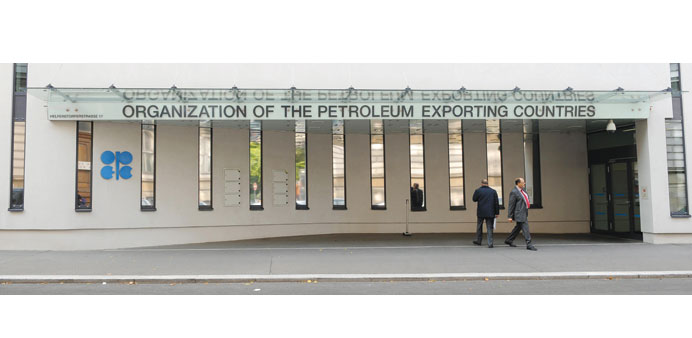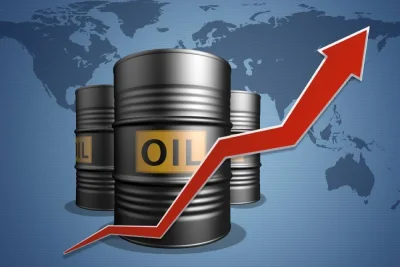A view of the entrance to the Opec building in Vienna, Austria (file). Opec’s 12 members are leaving in the ground about 3.63mn barrels of a total 34mn barrels they could pump each day. That is the highest level of untapped output since May 2011, with most of the surplus concentrated in the group’s largest member, Saudi Arabia.
Bloomberg/London
Opec’s biggest cushion of unused production capacity in two years is doing little to restrain prices, as threats to supplies from Algeria to Iran undermine the confidence that surplus crude usually creates.
Brent futures have advanced even as idle reserves expand in the Organisation of Petroleum Exporting Countries, moving higher in tandem at the fastest rate since at least 2006, according to data compiled by the International Energy Agency and Bloomberg.
Oil is facing unprecedented political threats, Goldman Sachs Group said last month, three days before Algeria was struck by the bloodiest assault on its energy industry in five years.
“On its own, if spare capacity is high, that will put a cap on prices,” said Amrita Sen, chief oil market strategist at consultant Energy Aspects Ltd in London. “But in a context where things are tight and can get worse, it has less of an impact. The change of sentiment came with the attacks in Algeria.” Brent crude futures, which advanced to a nine-month high above $119 a barrel on February 8, are expensive enough to derail the world’s economic recovery, according to the Centre for Global Energy Studies.
Opec’s 12 members are leaving in the ground about 3.63mn barrels of a total 34mn barrels they could pump each day. That is the highest level of untapped output since May 2011, with most of the surplus concentrated in the group’s largest member, Saudi Arabia. The kingdom reduced production to 9.1mn a day in January, the lowest level in almost two years, amid Opec estimates that the group is supplying more than consumers need. The country also cut official March price formulas for sales to Asia, its biggest customer region.
Prices have flared in the past during periods when surging demand has whittled Opec’s spare output, IEA data shows. The effective cushion of unused supply was at a two-year low of 1.48mn bpd in July 2008, when Brent soared to a record high of $147.50 a barrel. In December 2008, when the buffer increased to a more-than-two-year peak of 3.75mn as global recession prompted Opec to slash output, prices slumped to a four-year low of $36.61.
The IEA, the Paris-based adviser to oil-consuming nations, defines “effective spare capacity” as idled output that can be activated within 30 days and sustained for 90 days, excluding supplies locked in by security or political conditions in Iraq, Nigeria, Libya and Iran. Of the 3.63mn bpd currently available, 2.65mn bpd are held by Saudi Arabia.
“When spare capacity is quite low, it’s generally associated with higher prices,” said Leo Drollas, chief economist at the Centre for Global Energy Studies, a consultant in London founded by former Saudi Arabian oil minister Sheikh Ahmed Zaki Yamani. Still, the relationship with price is “tricky,” because the buffer often increases as a result of Opec production cuts, which tighten supplies, Drollas said.
Prices and spare capacity were moving in the same direction at the end of last year after Saudi Arabia cut production when the kingdom’s domestic demand sagged, causing Opec’s spare capacity to accumulate.
“Some of the latest gains in Opec capacity simply reflect production cuts,” and therefore may not act to soothe the market, the IEA said in its most recent monthly market report on February 13.
It’s not surprising that prices are rising even as spare capacity accumulates given that the build-up is due to restraint by Saudi Arabia, said Rob West, an analyst at Sanford C Bernstein Ltd in London.
“Saudi Arabia is dominating the picture more than at any time in the past, and they are cutting, which clearly sends a bullish signal,” said West, adding that spare capacity remains the second most-important element in determining oil prices after their marginal cost of production.
The increase in spare capacity is a consequence of production cuts that may limit its calming influence, the IEA said. Still, the failure of that extra oil to allay Brent’s rally is more to do with the scale of threats to production, as oil exploration companies evaluate the dangers of operations in places such as Algeria and Nigeria following militant attacks on energy infrastructure, the IEA estimates.
Geopolitical risks “are likely near an all-time high, with production in a very large number of countries at risk, including Egypt, Iran, Iraq, Libya, Nigeria, Sudan, Syria and Venezuela,” Goldman Sachs’ New York-based head of commodities research Jeffrey Currie said in a report on January 13.
The oil market is caught between signs of ample capacity and concern that supplies will be disrupted, Christof Ruehl, chief economist at BP, said at the International Petroleum Week conference in London on February 18.
While “there are very good fundamentals in the market, which is showing no signs of scarcity,” it’s balanced by “fear of supply disruptions mostly concentrated in the Middle East,” Ruehl said.
Algeria’s gas-processing plant was attacked by militants linked to Al Qaeda on January 16 in a four-day standoff that left at least 38 workers dead. Several European governments urged their citizens to evacuate Libya’s port city of Benghazi last month because of a security threat.
Talks between Iran, holder of the fourth-largest oil reserves, and UN officials on access to the country’s nuclear sites ended without agreement on February 13, and will resume in Kazakhstan on February 26.
“A new wave of political unrest in Africa is clouding the outlook in a growing number of countries,” the IEA said in its latest monthly market report on February 13. “So recent gains in spare capacity may not be as comforting in reality as they would otherwise appear.”



